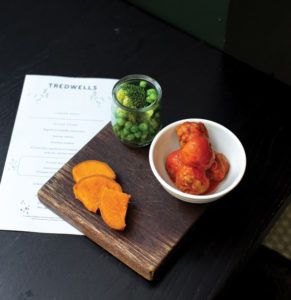Small wonders: Why chefs should consider downsizing their adult menu to cater for increasingly sophisticated younger diners
From Chantelle Nicholson's seven-course junior tasting menu at Tredwells to child-sized tacos at Wahaca, children's options are becoming increasingly sophisticated, not to mention healthier. Stephanie Sparrow looks at the latest options for younger diners
Octopus salad, coconut mousse and the much-maligned spinach are not the stereotypical components of children's menus, but far-sighted chefs and operators are realising that their young guests are becoming increasingly receptive to trying new foods.
"Children are savvy, more open to change and more engaged than they're given credit for," says Amanda Ursell, nutritionist for contract caterer CH&Co. On her school visits she sees children with an understanding of sourcing, sustainability and nutrition.
At Tredwells in London's Covent Garden, chef-patron Chantelle Nicholson has taken a sophisticated approach to feeding under-12s by offering them their own tasting menu. "We feel it is pertinent to be able to provide something that is interesting for children, to allow them to try new flavours and understand a little more about food," she says.
Offered as an alternative to the junior menu, Nicholson's culinary tasting menu costs £17 for seven courses. Dishes are seasonal and include roast beef salad and Cornish potatoes with aÁ¯oli, followed by marinated pineapple, passion fruit and coconut mousse.
Opportunities for young customers to try new flavours are not confined to the capital. At Oxford's Cuttlefish restaurant, owner Yola Drage wants children to be interested in more than "generic fish and chips" and encourages them to try a mini pot of mussels, a prawn cocktail or the octopus salad. "They can even take a peek at the oysters if they want to," she adds.
And in Lancashire, young customers at Preston's Plungington Hotel ask head chef Josh Clifton to cook a variety of dishes to order, including calamari or a four-ounce saffron and chilli-infused lamb burger (£5.50).
"Why should a restaurant exclude children from the things they like to eat at home?" asks Clifton, who is also planning a kids' food club on Saturdays with vegetable-growing classes in the restaurant's walled garden.
A small audience
All this innovation is worthwhile. An uplift in population figures means it is good business sense for the industry to re-evaluate its approach to younger diners.
"Given that the population of five- to 14-year-olds is projected to increase over the next five years, catering for families will be increasingly important," says Trish Caddy, foodservice analyst at Mintel. She adds that the concept of family-friendly has been redefined: "It is about reassuring parents that they can make healthy food choices when they are out."
Designing a children's menu to minimise fried foods and sugars need not be complicated, according to Michael Farquhar, operations director of restaurant group D&D London, which implemented a standard offering across all its company sites in June.
The three-course menu was introduced by executive chef Simon Gregory when he joined Bluebird Chelsea last year and developed further with Farquhar. It includes vegetable starters, a maximum of one fried item and a fruit dish, at a fixed price of £8, with a healthy drink and an activity book co-written by the pair. "We offer nutritious food that children actually like, and we encourage families to eat together," says Farquhar.
At Admiral Taverns, catering development executive Liezel Bezuidenhout believes that families are looking for a treat that is a healthy option too. As adviser to 430 taverns across southern England, she has noticed that licensees are meeting expectations by adding more vegetables to children's menus, either in the form of a main option such as spinach with pasta, or in side dishes, and by chargrilling food rather than frying it.
Parents are looking for balanced meals, according to Caddy. She points to Mintel's Burger and Chicken Restaurants 2018 survey, where more than a third of respondents (parents of under-18s) would like bigger portions of fruit and vegetables to be offered. "This ties up with the fact that 57% of diners say they are eating more vegetables than they did a year ago," she adds.
Parent power is having an impact. For example, the Out To Lunch campaign, run by the Soil Association, recruits parents as secret diners to rank the food and service offered to children by high-street restaurants and visitor attractions. The results are compiled in separate league tables that are frequently seized on by the national media.
"The league tables have created a race to the top," says Soil Association policy manager Rob Percival. "Many restaurants are now prioritising child health and investing in healthier and more creative meal options."
Beefeater was among the top five family-friendly restaurant chains in the 2017 Out To Lunch survey. Nathalie Pomroy chief marketing officer for Whitbread Restaurants, which owns the brand, says the chain offers a nutritionally balanced menu that appeals to children and parents alike.
"Every meal is served with a portion of vegetables, and some have two," she says. "We offer fresh fruit and lower-sugar puddings as well as healthier swaps from chips, such as brown rice or jacket potatoes. Tap water is freely available, and we offer a good choice of no-added-sugar drinks."
At Mitchells & Butlers, company nutritionist Sarah Jackson says the policy for children's food is written in line with the Soil Association and Children's Food Trust guidelines. "We continue to evolve our policy," she says. "For example, we are currently updating it to reflect the new guidance from the government's childhood obesity plan."
Smart choices
Smaller restaurateurs are also encouraging healthier habits among children. At least 52 restaurants have signed up to Sugar Smart, an initiative by food charity Sustain to reduce the overconsumption of sugar. Cuttlefish's Drage says that the scheme has prompted her to replace fizzy drinks with "tutti frutti" water (water glasses filled with slices of mixed fruit) at the restaurant, and to train staff to suggest "sugar swaps", by reminding parents fresh fruit is available when they order ice-cream.
Restaurateurs and families alike want children to enjoy food sensibly. At Wahaca, which sells 84,000 kids' meals a year, Turner says the "interactive aspect" of the children's menu makes it popular. Its success comes from letting children "build their own tacos and discover ingredients and flavours. Family dining is a way of learning about fresh, tasty ingredients and discovering flavour combinations while socialising with the entire family".
And at Devon's four-strong chain of Rockfish restaurants, owner and sustainability campaigner Mitch Tonks believes nutrition, food and fun can be compatible. He offers grilled options alongside a fish and chips menu and appeals to budding Attenboroughs with an Ocean Protectors scheme, which offers activity packs and T-shirts.
Tonks is trialling children's menus for his Exeter Quay restaurant, which opens this year. "We are looking at more ways to make food interesting to young people, such as serving crab in a shell," he says. "You know you've won when a child is eating seafood and enjoying it."
Calorie labelling legislation on the way Nearly a quarter of English children are obese or overweight by the time they start primary school, and the figure rises to one-third by the time they leave, at the age of 11. Last week the Department of Health and Social Care launched a public consultation on how to introduce calorie labelling for food and drink consumed outside of the home. The consultation will seek views on how this could apply to street vendors, restaurants with fast-changing menus and online takeaway businesses. The government, which intends to halve childhood obesity by 2030, says that overweight children are more likely to become overweight adults, who have a high risk of developing type 2 diabetes, certain cancers, strokes and heart disease. Public health minister Steve Brine says: "Families want to know what they are eating when on the go, but in many cafés, restaurants and takeaways this information is not available. "This is not about forcing anyone to eat certain things, or companies to behave in a certain way, but I firmly believe we have a right to know the nutritional content of the food we give to our children." !p2-offer-all-children-the-choice-of-a-childs-portion Many restaurateurs are already thinking ahead. At River Cottage (whose founder Hugh Fearnley-Whittingstall campaigns on obesity issues), food development manager Ben Bulger says it has cut the sugar content in most adult and children's desserts by between 15% and 20%, and lists calories and recommended daily allowance of fats and sugars on the pudding menu. Wahaca's managing director Mark Turner says the company is transparent about the calories in its children's pudding menu, and both Wetherspoons and Subway display information. But UKHospitality chief executive Kate Nicholls has expressed doubts. "A blanket introduction of mandatory calorie labelling would represent a serious additional cost for businesses already facing tightening margins and economic instability," she says, highlighting the burden on businesses which change their menus regularly. She adds that mandatory labelling in the US has not prompted customers to make healthier choices. "The sector is very keen to continue its work promoting healthier attitudes to food, but the introduction of inflexible legislation is unlikely to help, and UKHospitality will continue to make that point in its discussions with the government."
Should you ditch the kids' menu? Could limiting children to set menus inadvertently encourage food fussiness? At the University of Reading, professor of public health nutrition Orla Kennedy finds that even the repeated sight of food groups (such as green vegetables) in picture books stimulate children to accept new foods. "Increased exposure leads to better eating down the line," she says. According to Caroline Taylor of the Centre for Academic Child Health at the University of Bristol, children become confident about food when they mirror what their parents are eating. "Our research has shown that it is important that parents eat with their children, and eat the same foods, preferably not ready-prepared, to avoid their child becoming picky eaters," she says. "For this reason, we favour not providing special children's menus at all, but rather providing smaller portions of the regular menu items." There is a proviso here, though, that children under one year of age do not have salt added to their food at the table or in cooking. Ironically, a restaurant doesn't necessarily have to make use of overt gimmicks to wow children. At Manchester's 20 Stories, head chef Aiden Byrne says young customers are fascinated by the view over the city, while offering children smaller portions of the core menu does not affect Wagamama's high ranking in the Out to Lunch league table.

Continue reading
You need to be a premium member to view this. Subscribe from just 99p per week.
Already subscribed? Log In















